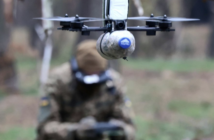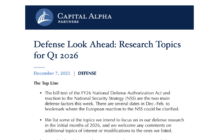Welcome to the CavasShips Podcast with Christopher P. Cavas and Chris Servello…a weekly podcast looking at naval and maritime events and issues of the day – in the US, across the seas and around the world.
This week, the blockbuster announcement this week of a new multinational deal for Australia to buy and build nuclear-powered attack submarines caught much of the naval world by surprise, and there are many more questions than answers at this point. We’ll be joined by our colleague Vago Muradian to discuss some of the many aspects of this deal, which involves and affects Australia, the United States, the United Kingdom, France and most importantly, China.
In this Week’s Squawk Chris Servello comments on the United States’ need to up its game .
Please send us feedback by DM’ing @CavsShips or @CSSProvision or you can email chriscavas@gmail.com or cservello@defaeroreport.com .
This Week’s Naval Round Up:
As we said, the heads of the Australian, British and US governments on September 15 announced the new AUKUS security partnership between the three countries, with the first major project to develop a nuclear-powered attack submarine program for Australia. The announcement effectively cancels the huge submarine program Australia had with France’s Naval Group to build 12 Attack-class subs in Australia based on a French design, an effort expected to cost more than $90 billion Australian — $70 billion US — over 25 years. In addition to the new submarine program, the AUKUS effort aims to include multiple efforts, including cyber, artificial intelligence and undersea capabilities. The move was widely condemned by China and by France, whose foreign minister called the cancellation “a stab in the back.” We’ll discuss this in more detail in a few moments.
The US carrier RONALD REAGAN has moved out of the Central Command operating area and chopped back to the US Seventh Fleet, USNI News reported September 16. The Japan-based REAGAN arrived in the CENTCOM operating area in late June to provide air cover for the US withdrawal from Afghanistan. Also on September 16 the USS ESSEX Amphibious Ready Group with the 11th Marine Expeditionary Unit entered the Persian Gulf to bolster the US presence in the area. The amphibious ships PEARL HARBOR and PORTLAND round out the ESSEX group.
The US revealed on September 13 that a four-ship Chinese naval group operated within the US exclusive economic zone near Alaska’s Aleutian Islands on August 30, shadowed by the US Coast Guard cutter BERTHOLF. The group, the US said, did not enter US territorial waters. The Chinese group was led by the Type 055 cruiser/destroyer NANCHANG, China’s largest and most sophisticated surface combatant, accompanied by the destroyer GUIYANG, a sophisticated intelligence ship, and a supply ship. The group left its Northern China bases around August 21 and returned around September 12, Chinese media noted the cruise was, quote, “a display of far-sea capabilities or countermeasure against US provocation.”
Two Iranian Navy ships that ventured around Africa and into the Baltic Sea to visit Russia returned to the Bandar Abbas naval base on September 12. The cruise of the base ship MAKRAN and frigate SAHAND that began in late May was widely reported to have been intended to deliver a cargo of high-speed attack boats and other weapons to Venezuela, but the ships never crossed the Atlantic, and instead arrived in Saint Petersburg in late July to attend Russian Navy Days. Whatever the true purpose, it is perhaps the longest-ever deployment by the Navy of Revolutionary Iran.
In aviation news, the Boeing-owned MQ-25 Stingray unmanned test aircraft on September 14 carried out its first aerial refueling of an F-35C Joint Strike Fighter. The UAV is being developed as a carrier-based tanker able to extend the range of aircraft like the F-35 and F/A-18 Super Hornets. Earlier aerial refuelings from the MQ-25 have been carried out with a Super Hornet and an E-2D Advanced Hawkeye aircraft.
This Week’s Squawk by Chris Servello:
Building on our conversation and on the notebook Vago released earlier in the week, my squawk is very simple. As Americans we have to do better. Better at policy, better at diplomacy and better at defense.
If we are going to stay ahead of the Chinese technologically, successfully avoid conflict and god forbid…win if war does break out, we need to be better.
The treatment of allies and partners over the last four years, followed up by the debacle in Afghanistan and now this week’s thumb in the eye to the French tell me and more importantly convey to the Chinese that we aren’t on our game.
Suddenly the smart guys in the White House, at the Pentagon and on the Hill don’t seem so smart.
Competition is about balancing the fulcrum of threats, opportunities and unforced errors…right now our balance is clearly off.
This isn’t a partisan issue…it’s an American issue…and it’s one we need to get our arms…and head around pretty quickly.




